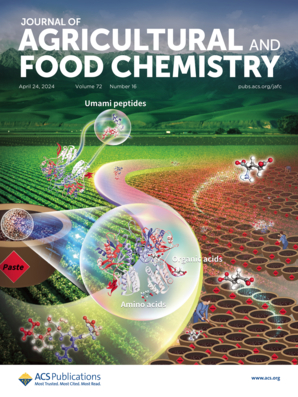Structural Basis and Recognition Mechanism of Host-Derived Volatiles by Olfactory Proteins in the Agricultural Pest Bactrocera correcta (Diptera: Tephritidae).
IF 5.7
1区 农林科学
Q1 AGRICULTURE, MULTIDISCIPLINARY
引用次数: 0
Abstract
Host-derived volatiles play a critical role in mediating plant-insect interactions. Bactrocera correcta is a destructive pest of fruit crops. In this study, we investigated the recognition mechanisms of three key volatiles─β-caryophyllene, ethyl decanoate, and hexyl hexanoate─derived from the host fruits of B. correcta. Using transcriptomic analysis, fluorescence binding assays, molecular docking, and molecular dynamics simulations, we identified BcorOBP19d-2 as a key odorant-binding protein that binds multiple volatiles and facilitates their stabilization and transport. Odorant receptors (BcorOR7a-13, BcorOR74a-3, and BcorOR7a-3) selectively recognize these volatiles, with hydrophobic interactions as the primary driving force for binding. β-Caryophyllene exhibited the highest binding specificity with BcorOR7a-13, ethyl decanoate demonstrated the strongest binding affinity with BcorOR74a-3, and hexyl hexanoate showed moderate stability with BcorOR7a-3. These findings provide structural insights into volatile recognition in polyphagous insects and offer a basis for developing attractants or repellents for pest management.农业害虫正确小实蝇(双翅目:蝗科)嗅觉蛋白对寄主挥发物的结构基础及识别机制
寄主来源的挥发物在植物-昆虫相互作用中起着关键作用。小实蝇是水果作物的一种破坏性害虫。在这项研究中,我们研究了三种主要挥发物──β-石竹烯、癸酸乙酯和己酸己酯──的识别机制。通过转录组学分析、荧光结合分析、分子对接和分子动力学模拟,我们发现BcorOBP19d-2是一个关键的气味结合蛋白,可以结合多种挥发物并促进其稳定和运输。气味受体(BcorOR7a-13、BcorOR74a-3和BcorOR7a-3)选择性地识别这些挥发物,疏水相互作用是结合的主要驱动力。β-石竹烯与BcorOR7a-13的结合特异性最高,癸酸乙酯与BcorOR74a-3的结合亲和力最强,己酸己酯与BcorOR7a-3的结合稳定性中等。这些发现为多食性昆虫的挥发性识别提供了结构见解,并为开发吸引剂或驱避剂提供了基础。
本文章由计算机程序翻译,如有差异,请以英文原文为准。
求助全文
约1分钟内获得全文
求助全文
来源期刊
CiteScore
9.90
自引率
8.20%
发文量
1375
审稿时长
2.3 months
期刊介绍:
The Journal of Agricultural and Food Chemistry publishes high-quality, cutting edge original research representing complete studies and research advances dealing with the chemistry and biochemistry of agriculture and food. The Journal also encourages papers with chemistry and/or biochemistry as a major component combined with biological/sensory/nutritional/toxicological evaluation related to agriculture and/or food.

 求助内容:
求助内容: 应助结果提醒方式:
应助结果提醒方式:


